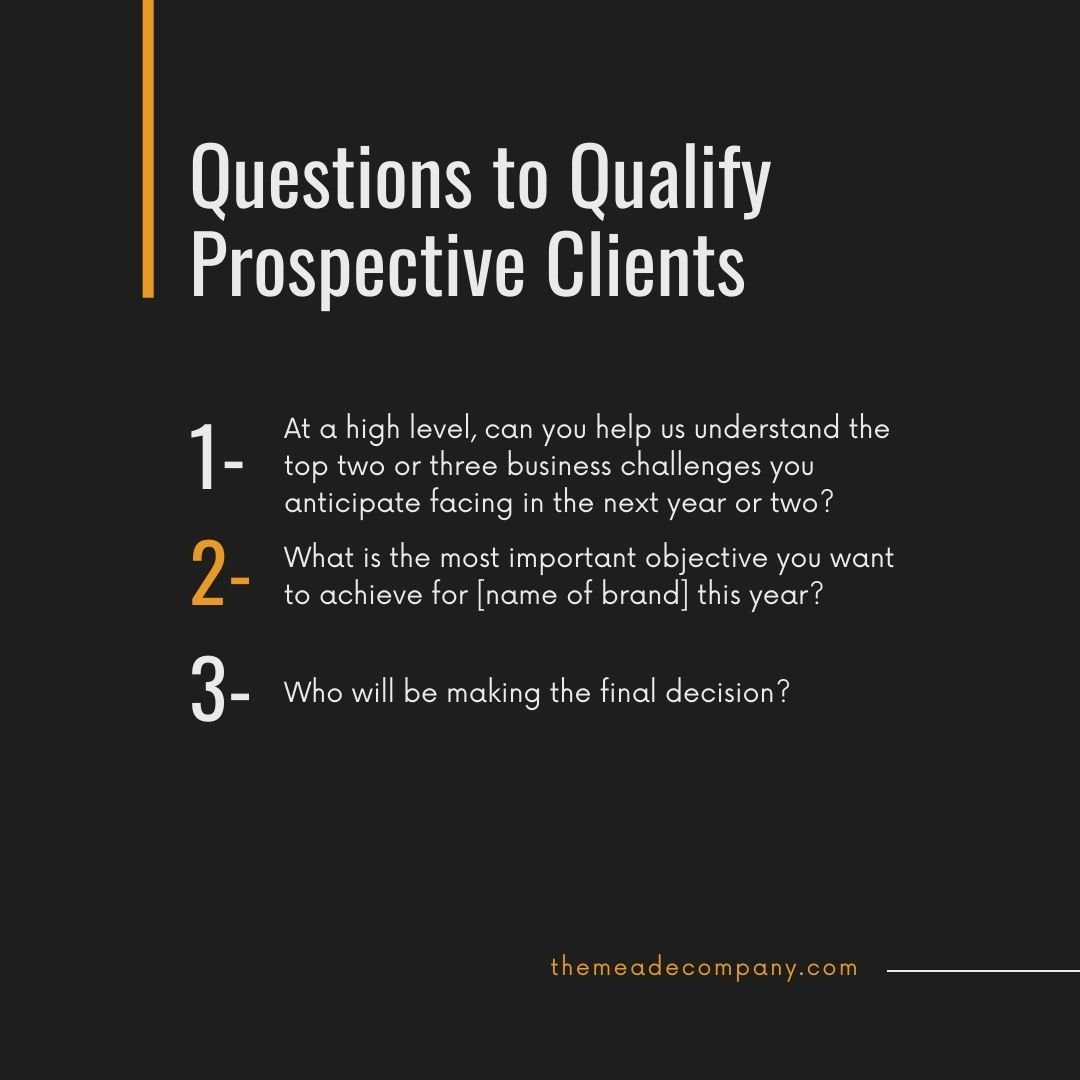Mastering Client Interviews to Close More Deals
As experienced agency leaders, you possess a sixth sense for extracting valuable information from clients. Your unique talent allows you to ask the right questions, delving deep into the heart of the matter. Over time, you've likely witnessed this skill in action with your own account staff. But on occasion, some of your junior team members may struggle to identify which questions will hit the mark with prospective clients.
Let's get real for a second. You've come a long way since the days of feeling ill-prepared in meetings with potential clients. Back then, you didn't always secure the crucial information you needed to craft a winning proposal. I bet that memory just resurfaced. It's a learning curve we've all been through. But when you're not around, your junior team members may lack the experience to ask the best questions. And guess what? You're partly to blame for that. Why? It’s because you've developed that intuition for knowing exactly what to ask and when to ask it. You have systems and processes in place for onboarding clients and service delivery; but ultimately, there's no cheat-sheet to guide those initial sales conversations when you're not in the room.
That's where this article comes in. My goal is to provide you with a simple, handy guidebook—a go-to resource for your sales conversations. These questions are designed to help you uncover what truly matters to prospective clients, get a better grasp of the challenges they face, and understand what they consider a successful outcome. Feel free to take these questions, modify them to fit your style, and make them your own.
QUESTIONS TO QUALIFY PROSPECTIVE CLIENTS
Question 1: At a high level, can you help us understand the top two or three business challenges you anticipate facing in the next year or two?
The wording "at a high level" is important, as it encourages clients to think strategically. Far too often, clients have already diagnosed their problems and want to position your agency as a cost-effective solution. In doing so, they will prematurely focus on pricing. By slowing them down, you can steer the conversation towards the big picture: strategy, not just tactics. It's essential to emphasize the time-bound nature of these challenges as well, compelling the prospect to act today to address the challenges of tomorrow.
Question 2: What is the most important objective you want to achieve for [name of brand] this year?
This question encourages clients to do two things: prioritize their wish list, and identify the outcomes that your expertise can address. While they may bring up additional wants and needs later in the conversation, having this answer allows you to establish boundaries for your work and place a focus on specific outcomes. Moreover, this question serves as an antidote to scope creep down the road. You can reference it when clients suggest something that is out of scope.
Question 3: Who will be making the final decision?
Inexperienced professionals often overlook this question, simply being content with anyone who agrees to a meeting. However, it's crucial to make this inquiry early on to determine who holds the ultimate decision-making authority. Oftentimes, the person who reaches out to you is responsible for implementation, while their boss has the final say. Once you know who the decision-maker is, you'll have a better idea of who needs to answer the previous questions.
RED FLAGS WHEN QUALIFYING PROSPECTIVE CLIENTS
This section is less about questions, and more about red flags to be aware of. We've all dealt with challenging clients; and in hindsight, the warning signs are painfully obvious. While experience is the greatest teacher, wouldn't it be nice to identify red flags when qualifying prospective clients?
Red Flag #1: Commitment-Phobia
A prospect's fear of commitment can manifest in various ways, including:
Working with numerous agencies in the past and never being content.
Stories of past disappointments with former agencies.
A desire for consistent project work instead of a long-term agreement that would benefit both parties
Red Flag #2: Attempts to Negotiate Fees
Clients often don't have a set price in mind for fees. But oddly enough, they take on the persona of a car buyer and simply want to negotiate you down to a lower price.
RFP requests are notorious for this bad behavior. The client will reach out to you somewhere around the final round, and ask for your best and final offer. This is code for “give me a better rate.” Considering that you've already given them your fees in writing, this is a red flag. This type of client will want to push you toward charging by the hour.
The client might use the classic line, "You'll be able to get a lot of exposure working on this project." This one used to get me early in my career. For anyone that has struggled with impostor syndrome, getting exposure sounds logical; you believe that the work will validate you for future opportunities. In reality, this is just a ploy to avoid paying your requested fees.
“Let’s just start the project, I’ll get accounting to send out the payment.” You've heard this one before. While they are not blatantly negotiating fees, they are being loose with your payment schedule.
“We’re working with a limited budget, and can’t pay that much right now." This sounds like someone who cannot afford to work with you. Unfortunately, you’ve made exceptions in the past—even when this language is a clear red flag.
Red Flag #3: They Don't Follow Your Process
Your agency has established specific processes that increases the likelihood of successful outcomes—and a client comes along who wants to alter your method. This behavior indicates a lack of respect for your expertise. It implies that the prospect believes they can do it better.
KEY QUESTIONS TO IDENTIFY PAIN POINTS
To motivate prospects to take action, you must help them recognize the urgency of addressing problems. The following questions are designed to reveal their pain points:
Question 1: What two or three outcomes would you like to see?
You want prospects to imagine the positive change they would experience from seeing one or more of these outcomes happen. This question helps you create solutions that bridge the gap between their current situation and their desired outcomes. By focusing on outcomes rather than deliverables, you can address the underlying reasons behind their requests. For instance, let's say a prospect wants a bigger logo. Your goal is to uncover the desired outcome behind that request.
Question 2: What would happen if you did nothing for the next [three months]?
Tailor the timeframe to the prospect's current situation. Through this method, you can help them visualize the consequences of maintaining the status quo. By highlighting the timeline, you create a sense of urgency and emphasize the limited time available to address the problem before it worsens.
Question 3: Can you quantify the costs associated with this problem (monthly or annually)?
This question aims to justify the marketing investment required to solve the problem. Oftentimes, the cost of solving the problem through marketing is a fraction of what the problem currently costs the prospect (in terms of lost sales or missed opportunities). Encourage them to consider the actual financial impact of the problem. When you present your fees, they will pale in comparison.
QUESTIONS TO REACH THE NEXT STEPS
Question 1: On a scale of 1 to 10, how important is [insert one of the outcomes] to you?
Evaluate whether your prospect sees an immediate need to solve the problem. By having them acknowledge the issue's importance, you instill a sense of urgency, making it easier to transition the conversation towards delivering a proposal. Without a sense of urgency, they can easily ghost you once you send the proposal.
Question 2: What options are you currently exploring?
If prospects are actively exploring alternative options, it demonstrates their commitment to solving the problem and their seriousness in seeking a resolution.
Question 3: What questions do you have for us?
Prospects will undoubtedly have questions about working with your agency. This is an ideal opportunity to guide them through your process, ensuring they understand your experience in solving similar problems for businesses like theirs.
ENCOURAGE A PAID DISCOVERY SESSION
At this point, you should echo the ideas your client has expressed, assuring them that you understand their desired outcomes. This is the point where many agencies mess up. You begin pushing a 12- or 24-month solution onto someone who has just met you. Instead of overwhelming this person you've just met, it's wise to go slow and start "dating." In other words, transition the conversation to a discovery session—a smaller-scope, lower-priced introductory service for your agency clients. Discovery sessions go by many other names: road-mapping projects, growth plans, client audits, and strategy sessions. By offering this service, you can immediately identify and disqualify prospects with an unrealistic timeline or those without a budget. Once you conduct the discovery session, you will better understand whether the challenges they have are challenges you can actually solve.
NEED FURTHER ASSISTANCE WITH CLIENT INTERVIEW QUESTIONS?
In my agency coaching program, I assist agency owners in developing their own set of sales questions. Additionally, I can help you enhance your sales skills to generate consistent leads and optimize your service offerings.
By employing the questions in this article, you can effectively tailor your sales process to both your needs and those of your prospects. These probing questions are designed to elicit the necessary information and prompt your prospects to take action.





